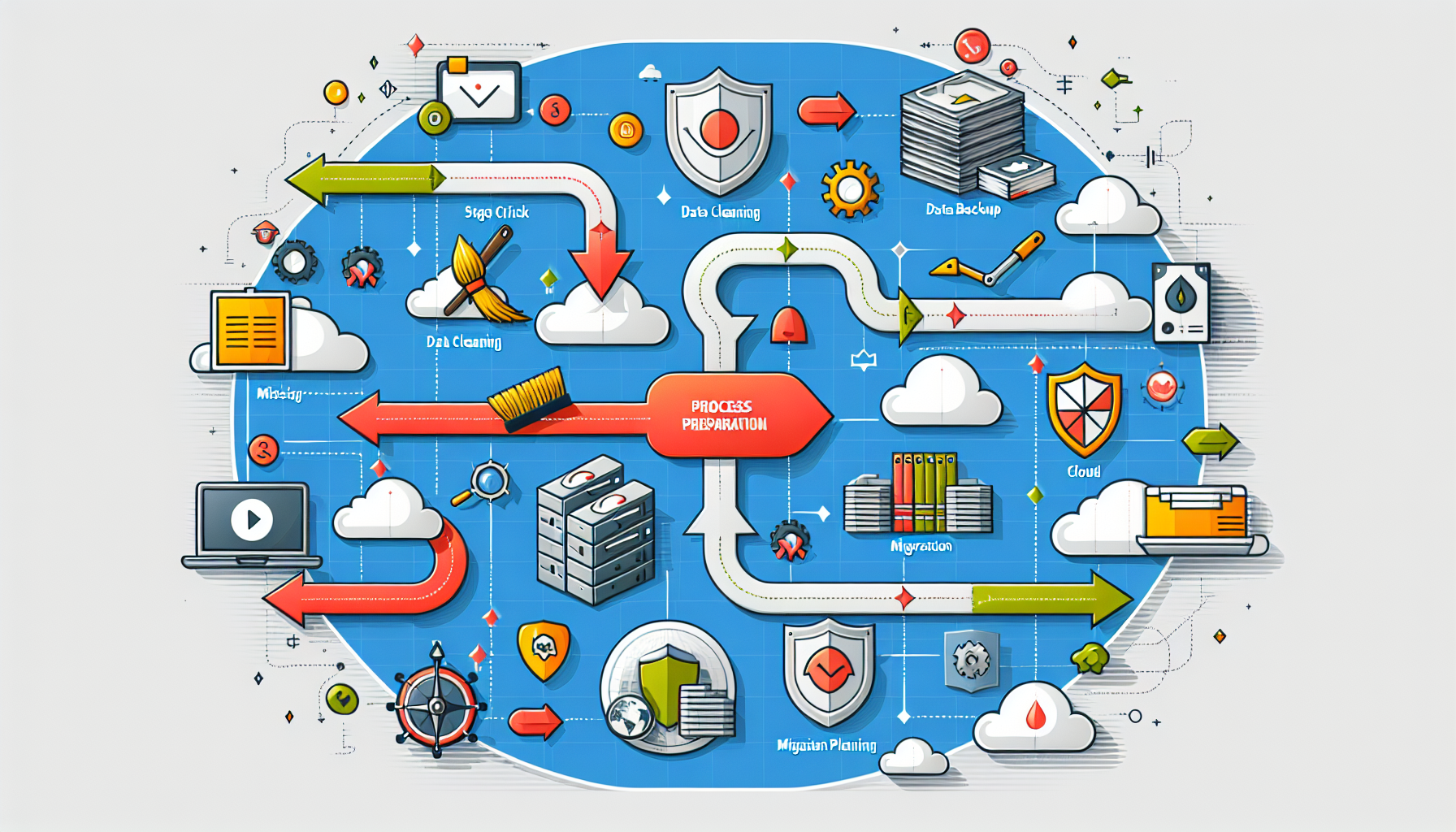Optimizing Salesforce HubSpot Migration: Essential Tips and Tricks
Looking to migrate from Salesforce to HubSpot? This guide walks you through each key step of the migration process. Learn how to prepare your data, understand platform differences, and optimize your new CRM system. Ensure a smooth and successful Salesforce HubSpot migration.
Key Takeaways
Thorough preparation, including data cleaning and backup, is crucial for a smooth Salesforce to HubSpot migration.
Understanding platform differences and planning a clear migration strategy can help address potential challenges and streamline the transition.
Post-migration, ongoing support and performance tracking are essential to optimize HubSpot’s capabilities and ensure long-term success.
Preparing for Migration
Prior to initiating the CRM migration process into a new CRM, meticulous planning is imperative. This stage encompasses critical actions such as purging unnecessary data, securing a backup of key data, and analyzing current CRM utilization to guarantee an error-free transfer.
At the outset of this preparatory phase lies data cleaning. It’s essential to migrate only pertinent and current information in order to preserve the integrity of your data. This means eliminating duplicate entries and rectifying any discrepancies found within your records.
Establishing a comprehensive strategy for backing up crucial data is pivotal in preventing loss during the transition period. By scrutinizing both quality and applicability, it ensures that you import only indispensable information into HubSpot.
Solid preparation lays down the groundwork for smooth sailing when switching over to your brand-new CRM platform.
Data Cleaning
Ensuring data integrity through meticulous data cleaning is paramount in the process of migrating to HubSpot. Before initiating a migration, it’s essential to delve into the structure and governance rules associated with your database. This step entails identifying and rectifying any duplicates, inconsistencies, or extraneous details present within your records. Merging or updating partial entries helps guarantee that only complete and useful information is carried over during the migration.
Strategically organizing your data prior to its transition can significantly streamline the entire process while safeguarding logical record sequencing upon arrival in HubSpot. Committing time for this preparatory work also reduces potential risks associated with losing critical data points as you migrate. It ensures that each new entry aligns correctly within the new system architecture—ultimately enhancing both efficiency and outcome quality throughout your transfer endeavors.
Data Backup
Establishing a data backup is an essential safeguard within the process of migrating data. It is crucial to export data, such as leads and accounts, in .csv format before cleaning it for further use. This preserved dataset acts as a checkpoint, enabling error detection like misspellings and instances of missing information, thus ensuring there’s recourse should complications arise throughout the migration.
Employing SyncMatters’ Data Exporter comes highly recommended for creating backups of Salesforce data due to its proficiency in extracting data specifically for this purpose. The timeline required to complete the backup may fluctuate based on elements such as your specific volume of data and system idiosyncrasies.
Having a thorough backup in place protects your critical data, instilling confidence as you embark on the migration journey.
Create a Change Management and Communications Plan
Migrating from Salesforce to HubSpot requires a well-planned change management and communications strategy to ensure a smooth transition for your sales team. This plan should include the following:
Communicate the Reasons and Benefits: Clearly communicate the reasons for the migration and the benefits of using HubSpot. Highlight how HubSpot’s features can address current pain points and enhance overall productivity.
Provide Training and Support: Offer comprehensive training and ongoing support for the sales team on how to use HubSpot. Utilize webinars, tutorials, and hands-on sessions to ensure everyone is comfortable with the new system.
Establish a Timeline: Develop a detailed timeline for the migration and provide regular updates on progress. This helps manage expectations and keeps everyone informed about key milestones.
Address Concerns and Resistance: Identify and address any concerns or resistance from the sales team. Open communication channels and provide reassurance to ease the transition.
Plan for Data Migration: Develop a robust plan for data migration, ensuring data integrity throughout the process. This includes data cleaning, backup, and precise data mapping.
Testing and Validation: Establish a process for thorough testing and validation of the migration. This includes functional testing, data verification, and ensuring all workflows operate as expected.
A well-planned change management and communications strategy will help minimize disruptions to your sales team and ensure a successful migration to HubSpot. By keeping everyone informed, trained, and supported, you can facilitate a smooth transition and maximize the benefits of your new CRM system.
Assessing Current CRM Usage
Evaluating how your current CRM is utilized is critical for a successful transition. Reflect on your business goals and present workflows to pinpoint what should be carried over, and scrutinize your technology stack to see whether it could benefit from consolidation or enhancement.
Spotlighting the principal items that must move from Salesforce to HubSpot is vital for an uninterrupted changeover. It’s advisable as well to reexamine the CRM functionalities after one year of operation to verify their congruence with your ongoing business aims.
A comprehensive review of how you currently leverage your CRM will guide wise choices, guaranteeing that the new system fulfills all operational requirements.
Assess Your Current Sales Process
Before migrating from Salesforce to HubSpot, it’s essential to assess your current sales process to identify areas that need improvement and opportunities for optimization. This step will help you understand how your sales team uses Salesforce and what features they rely on the most.
To assess your current sales process, consider the following:
Identify Pain Points: What are your sales team’s pain points with Salesforce? Understanding these challenges can help you address them in HubSpot.
Feature Utilization: What features do they use the most, and how do they use them? Knowing this will ensure that critical functionalities are seamlessly transitioned.
Align Goals and Objectives: What are your sales team’s goals and objectives, and how do they align with your overall business strategy? This alignment is crucial for setting up HubSpot to support your business effectively.
Evaluate Workflows and Processes: What are the current workflows and processes in place, and how can they be improved? Streamlining these processes in HubSpot can enhance efficiency.
Data Tracking and Usage: What data is currently being tracked, and how is it being used to inform sales decisions? Ensuring that key data is accurately migrated and utilized in HubSpot is vital.
By understanding your current sales process, you can identify areas where HubSpot can provide improvements and optimize your sales team’s workflows. This thorough assessment will pave the way for a more efficient and effective sales process in your new CRM environment.
Understanding Platform Differences
Grasping the distinctions between Salesforce and HubSpot is crucial when transitioning from one to the other. Companies typically shift from the Salesforce platform to HubSpot in pursuit of a simpler, more user-friendly platform or because they find Salesforce too complex. As an integrated solution for marketing, sales, and service tasks, Hubspot offers a seamless experience that differs notably from that provided by Salesforce.
The approachable interface of Hubspot leads to improved engagement and productivity among both sales representatives and customer support staff. We will delve into how features align across these platforms as well as highlight any variations in terminology you might encounter while moving your operations over—ensuring you’re fully prepared for what lies ahead during this migration process.
Feature Comparison
Known for its robust customization capabilities and sophisticated functionalities, Salesforce caters to the intricate needs of larger enterprises. Conversely, HubSpot provides an array of marketing tools even within its complimentary and more affordable plans—a feature set that differs from what Salesforce offers.
HubSpot presents a complimentary tier with essential CRM features at no cost, which is not an option available with the Salesforce CRM. Recognizing these distinct differences in offerings can assist you in choosing the most suitable platform tailored to your business requirements.
Terminology and Interface
Transitioning from Salesforce to HubSpot can present challenges for users, particularly due to the different terminologies employed by each platform. An example of this is how a ‘Deal’ in HubSpot corresponds to an ‘Opportunity’ in Salesforce. It is essential for users migrating between these platforms to acclimate themselves with the new terminology for a smooth migration process.
There are considerable differences between the user interfaces of both Salesforce and HubSpot that may affect user navigation and interaction with each system. Grasping these variations not only in terms but also in interface design will facilitate your team’s quicker adaptation to working within HubSpot, contributing towards a more efficient transition period.
Planning Your Migration Strategy
Ensuring a seamless shift from Salesforce to HubSpot requires the development of a comprehensive migration strategy. This stage necessitates recognizing possible difficulties that could arise during the migration and devising suitable measures to counteract these obstacles. The presence of compact data volumes and simple object configurations may expedite this process.
It is critical to select optimal times for making the switch in order to reduce impact on business operations, preferably when activity levels are at their lowest. Our role will involve assisting you in establishing a schedule for your migration venture and judiciously distributing resources needed for its successful execution.
Timeline Creation
Establishing a schedule for the migration process is key to facilitating an effortless changeover. Prior to initiation, comprehensively delineate your data and thoroughly acquaint yourself with all implicated systems. Utilizing instruments such as SyncMatters’ Data Exporter aids in averting any loss of data throughout the backup phase.
Typically, businesses are able to finalize the migration within a three-month period. This duration varies with the complexity of their specific migration scenario. It’s essential to clearly convey both cutover details and requisite modifications not only to team members but also stakeholders, guaranteeing they’re on board. Crafting an intricate timeline plays a crucial role in setting expectations and assures seamless adaptation when transitioning into HubSpot’s ecosystem.
Resource Allocation
Allocating resources efficiently is essential for a successful migration from Salesforce to HubSpot. Utilizing tools such as the MigrateMyCRM online estimator can help in assessing the potential costs of migration, offering an initial insight into budgetary needs. It’s important to recognize that these cost estimates may vary depending on specific project requirements and subsequent modifications.
It is critical to identify both the types and quantities of data that will be transferred during the migration process before finalizing any cost estimations since this directly influences resource allocation. Engaging with a HubSpot Solutions Partner could prove beneficial. They can aid in reviewing your current tech stack and deciding which software or plugins might no longer be necessary, ultimately optimizing resources throughout the hubspot migration process.
Ensuring proper allocation of resources leads not only to a smooth transition, but also contributes significantly towards achieving an economical and efficient Salesforce to Hubspot data transfer process.
Migrating Data
Migrating data from Salesforce to HubSpot is a critical step in the migration process. This involves using HubSpot’s native tools or third-party solutions to transfer data. Data migration can involve exporting a variety of salesforce records, including contacts, companies, deals, and custom objects.
We’ll explore different migration options, including integration tools, manual data export and import, and field mapping. Understanding these options will help you choose the best method for your specific needs, ensuring a smooth migration process.
Integration Tools
The use of integration tools greatly simplifies the data migration process when transferring information from Salesforce to HubSpot. A prominent advantage of these tools, especially with the HubSpot Salesforce integration, is their ability to synchronize data bi-directionally between both platforms without interruption. Renowned choices for this task include Zapier, Workato, and Mulesoft along with the native HubSpot Salesforce integration.
Utilizing these instruments enables automated transfer of data, which enhances efficiency and diminishes chances for mistakes during the migrating activity. Employing such tools not only expedites moving data, but also plays a crucial role in maintaining its accuracy and integrity throughout the process, ensuring that both systems remain harmoniously integrated.
Manual Data Export and Import
If integration tools cannot be used, manually downloading and importing CSV files is another option. Before importing data into HubSpot, double-check for accuracy to avoid issues during the transfer. HubSpot’s native migration tool supports importing various records, including contacts, companies, deals, tickets, products, notes, and custom objects.
For help with migration and data migration packages for HubSpot, SyncMatters is a useful resource. Carefully managing the manual data export and import process ensures a successful data migration.
Field Mapping
Ensuring the precision of your data during a migration hinges on effective field mapping. It is pivotal to align Salesforce fields with HubSpot properties for an accurate transfer of data. Meticulous examination of field names and tailored data frameworks plays a significant role in realizing seamless data mapping.
Utilizing utilities such as MigrateMyCRM can facilitate the process by leveraging common logic to automate the assignment of data fields. This attentive approach to field mapping guarantees that all pertinent information is precisely transitioned and operational within HubSpot’s environment.
Setting Up HubSpot
Following a triumphant data migration, the configuration of HubSpot is key to ensuring flawless operation. This requires establishing user permissions, crafting custom fields, and instituting workflows and automations. Such meticulous setup is critical in preserving the organization’s hierarchy and safeguarding data integrity after the migration.
Given that HubSpot presents a more intuitive interface than Salesforce’s intricate layout, it simplifies the transition for users unfamiliar with it. This segment will provide detailed guidance on essential steps to set up HubSpot so your team can smoothly transition to and begin proficiently utilizing the new system without delay.
User Permissions
In HubSpot, configuring user permissions is crucial for preserving the team structure and ensuring data integrity after migrating data. The process entails establishing account permissions, enforcing security protocols, and developing essential custom objects within HubSpot. By tailoring user roles, access to various functionalities of HubSpot can be controlled in accordance with the organizational hierarchy.
After completing a migration into HubSpot, it is critical to implement security measures such as single sign-on (SSO) and two-factor authentication (2FA). These settings help protect sensitive content by correctly defining who has permission to access specific information within Hubspot—thereby maintaining the integrity of your data post-migration.
Custom Fields and Properties
The capability to construct custom fields in HubSpot allows for the adaptation of your CRM to monitor distinctive data pertinent to your business operations. Custom fields are readily established via the settings menu, presenting an uncomplicated method for their configuration. These specialized fields can hold particular data categories that correspond with the unique requirements of your company.
By personalizing these custom fields, you ensure that any transferred data is adeptly managed within HubSpot’s framework. Modifying these fields and properties guarantees that your new CRM infrastructure underpins both your business strategies and goals effectively.
Workflows and Automations
Maintaining your business processes is essential when replicating Salesforce workflows within HubSpot. By utilizing the Workflows tool in HubSpot, you can initiate automations for internal procedures and external communications effectively. Ensure that your strategic plan encompasses all critical actions and components required to finalize the Workflow.
To validate email campaign effectiveness, it’s crucial to conduct tests by sending sample emails while verifying their successful delivery and content precision. Establishing workflows and automations in HubSpot is pivotal. It empowers your team to sustain high levels of efficiency and efficacy throughout their operations.
Quality Assurance and Testing
After the data has been transferred, quality assurance and testing are critical to confirm that all functions are performing accurately within the new system. Executing a post-migration audit helps pinpoint any potential issues, while also ensuring everything operates according to plan in the fresh environment.
It is essential during this QA phase to rigorously examine components such as automation protocols, lead scoring systems, workflows, and email sequences. An exhaustive test of your newly implemented system will guarantee that all data and features function properly thereby reducing any interference with daily business activities.
Data Verification
Before importing the data, ensure its correctness to prevent problems in the transfer process. Once migration is complete, perform a post-migration audit to make sure that all essential data has been accurately transferred. To detect any possible issues effectively, use a varied set of data for testing.
Carrying out rigorous verification of your data upholds its integrity and reduces the chances of losing or corrupting information. Such attention to detail is crucial for preserving high-quality CRM data after the migration process.
Functional Testing
Ensuring the migration of all necessary data and proper dashboard operation is verified through functional testing. To confirm that workflows operate as expected, employ test contacts during your evaluations. Post-migration, it’s essential to observe automations and procedures closely for any irregularities.
For email marketing campaigns within the new CRM, conduct trials by sending emails to check both their deliverability and accuracy in content. Constructing test contacts with diverse attributes allows you to assess the integrity of the lead scoring mechanism thoroughly. A comprehensive examination of every function guarantees that your fresh CRM system functions seamlessly and efficiently.
Going Live with HubSpot
When launching HubSpot, it is crucial to keep stakeholders well-informed about the status of the migration and any imminent modifications. A defined communication strategy should be in place that clearly conveys updates on key milestones, potential effects, and subsequent actions related to the migration process.
To facilitate a seamless shift to HubSpot, provide thorough training for your team members so they become proficient with its features and workflows. This can involve leveraging educational materials like webinars, tutorials, and guides aimed at empowering them with the necessary skills to navigate HubSpot confidently.
By preparing both your team members and stakeholders adequately through these steps, you lay down a solid foundation for a successful activation of Hubspot’s functionalities during go-live.
Communication Plan
Involving stakeholders from the outset is crucial to set clear expectations and obtain important perspectives. It’s essential to solicit feedback and resolve any queries from these key participants before initiating the migration process. Implementing a comprehensive communication strategy ensures that everyone is made aware of significant timelines and necessary modifications.
Maintaining transparent communication regarding the cutover and subsequent alterations is fundamental in reducing misunderstandings among team members. By putting in place a strong communication framework, it guarantees that all parties are consistently updated and remain coordinated throughout the entire migration process.
Team Training
The training program ought to underscore the capabilities of HubSpot as well as their application within the distinct workflows of our team. After transitioning to HubSpot, it’s vital that the instruction centers on hands-on use and details pertinent to how the system has been set up for our company. Continuously communicating about new features is essential in maintaining an enthusiastic and knowledgeable sales force.
Ensuring thorough education supports your sales force by equipping them with a deep understanding necessary for leveraging HubSpot successfully, thus preserving streamlined processes and optimizing all advantages offered by this recently adopted CRM platform.
Post-Migration Optimization
After successfully migrating to HubSpot CRM, it’s crucial to regularly refine your setup in order to leverage all of its functionalities effectively. Post-migration support is essential for resolving any queries or challenges that arise from the transition from Salesforce. This stage includes vigilance over automation processes to detect and resolve issues promptly and the establishment of custom fields which can significantly improve how data is organized and accessed.
Employing the integrated SEO tools provided by HubSpot can lead to better website performance and increased online presence. Persistent enhancement ensures you’re making the most out of what HubSpot CRM has on offer, facilitating an efficient and productive environment for your team within this new system.
Ongoing Support
Continual support and resources after the initial training can increase your team’s mastery of HubSpot. Regular trainings are critical for helping the team adjust to and make full use of HubSpot efficiently. Customizing training materials for different positions within the team can improve their expertise.
Ensuring enduring success with HubSpot is facilitated by a blend of persistent support and bespoke training programs. Providing constant assistance guarantees that your team keeps abreast of developments and feels assured when operating the new CRM platform.
Performance Tracking
Regular training ensures that the team remains knowledgeable about new features in the CRM, which helps avoid unproductive efforts. The reporting tools of HubSpot yield important data on performance indicators, giving teams the capability to monitor their progress with precision. A routine examination of reports can identify areas that are not performing well and help focus improvement efforts where they are most needed.
By continuously monitoring performance metrics and implementing changes based on solid data, your business is poised to keep reaping rewards from the new CRM system, thereby fostering growth and increasing operational efficiency.
Summary
To ensure a seamless shift from Salesforce to HubSpot, it is essential to carry out several vital actions. These include meticulous planning, grasping the distinctions between platforms, executing a well-thought-out migration strategy, and committing to extensive quality assurance and testing processes. By adhering to these procedures, you can facilitate an effortless transition while taking full advantage of what HubSpot has to offer.
It’s important not to view the migration as the final step. Rather continuous optimization and dedicated support are crucial for sustaining operational effectiveness and unleashing the full capabilities of your new CRM solution within HubSpot. Seize this opportunity for change with open arms—allow HubSpot to revolutionize how you cultivate customer relationships and propel your enterprise ahead.
Frequently Asked Questions
What is the first step in preparing for a Salesforce to HubSpot migration?
The first step in preparing for a Salesforce to HubSpot migration is data cleaning. This means making sure all your information is relevant, up-to-date, and free of duplicates or inconsistencies.
Why is it important to back up data before migration?
It’s crucial to back up your data before migration to avoid potential loss during the transfer. A reliable backup ensures that you can restore any important files if something goes wrong.
What are some popular integration tools for migrating data from Salesforce to HubSpot?
If you’re looking to migrate data from Salesforce to HubSpot, consider using HubSpot’s Salesforce integration, Zapier, Workato, or Mulesoft.
These tools are widely favored for their effectiveness in seamless data transfers.
How can you ensure data integrity during the migration process?
To ensure data integrity during migration, focus on thorough data cleaning, precise field mapping, and always run post-migration audits.
These steps will help you maintain accuracy and trust in your migrated data!
What resources are available for ongoing support post-migration?
You can access tailored training resources, regular CRM updates, and HubSpot’s built-in tools to ensure continuous improvement and support after your migration.





